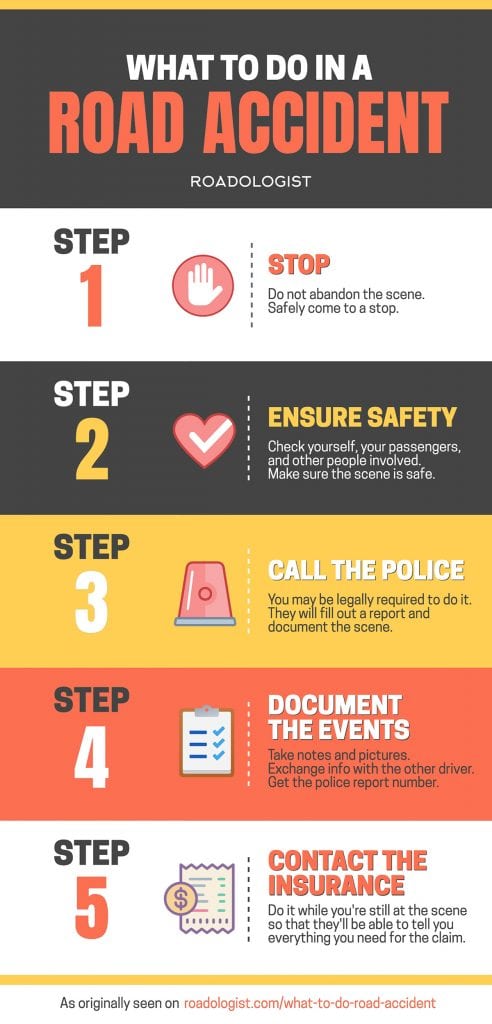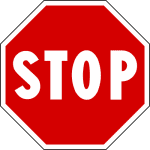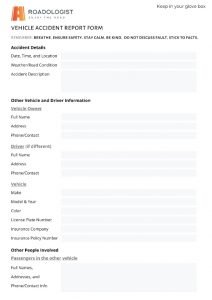Do you know what to do in case of an accident on the road?
According to statistics, more than 12 million road accidents occur each year in the United States.
If this number gives you a sense of unease and leaves you a bit shaken about your confidence to manage an accident on the road… then this guide is for you.
We know how stressful a car accident can be. And as with most things automotive, the best way to manage it is to prepare.
Knowing what to do after a road accident is a very important piece of driver education. But not many people actually know the steps to take after a car accident, unfortunately. Until it’s too late.
We created this car accident checklist to help you deal with the aftermath of a road accident. Keep these steps in mind (and this list readily available) should you ever find yourself in one.

1. Stop

Even if it’s a minor accident (e.g., a fender-bender), you should stop.
Do not abandon the scene. It is irresponsible and considered a crime in most states. If your car is still running, safely come to a stop.
2. Ensure Safety
Check Yourself
If you’re injured or in any kind of physical pain, call the emergency services (911 in the US, 112 in most other parts of the world) or ask someone else to do so.
If you’re seriously injured, try not to move, and wait for emergency personnel.
Check On the Other Passengers
If you’re not too hurt to move, check on the other passengers in your car.
If anyone’s injured, call the emergency services or ask a bystander to do it.
Make Sure the Scene is Safe
If your car is safe to drive and is causing a dangerous hazard where it is, pull it to the side of the road.
Otherwise, leave it where it is.
Turn off the engine and turn on the hazard lights. Then move to the side of the road or a sidewalk and get yourself and the other passengers to safety.
Check On Other People Involved in the Accident
Again, only if you can move safely, check on the other people involved in the accident. If anyone’s injured, call 911 or ask somebody else to do it.
Further Ensure the Safety of the Scene
If it’s appropriate, use the traffic warning triangles/cones (or even better the road flares) in your emergency car kit to warn other vehicles to slow down.

3. Call the Police
Whether the accident is a minor fender-bender or a major collision, calling the police is fundamental – and in some states, it’s legally required.
The responding officers will fill out an accident report and document the scene. And your insurance will generally ask you for this report to settle the claim.
In the unlikely event that the police can’t come to the scene of the accident, you can and should go to the nearest police station and complete a report yourself.
4. Record and Document the Events
As you wait for the police, if the circumstances allow it, you may begin documenting the events.
In all your interactions with other people involved in the accident, be always very polite and compassionate.
A car accident is always a very stressful situation. No matter whose fault it is, don’t lose your temper. Getting angry is useless and will only make it worse.
Be kind and understanding.
Do not discuss fault. Do not admit it (even if it is your fault). Do not blame (even if it is their fault). It is useless and counterproductive. When you file an insurance claim, the adjuster reviewing your claim will determine who’s at fault. The decision will be based on an inspection of the vehicles/property damaged, the information provided by you and the other parties involved in the accident, and any supporting documentation (like the police report or photographs from the scene).
So stick to the facts. Just describe the events as they took place. Do not add anything more.
Take Notes
You should write down as much information as you can about the accident, so that you’ll have everything your insurance may ask you for the claim.
Get it all down while you are at the scene if possible. It’ll be far easier and you’ll have all the details fresh in your mind.
Some jurisdictions or insurance companies actually distribute their own car accident report forms to help you gather all the details from the event.
If you don’t have one, we built a form with all the most useful and commonly asked details to guide you in the data gathering.
Print a couple of copies and have them in your vehicle. Just in case. It’ll be a great aid should the situation ever arise.
Take Pictures (and Video)
If it’s safe to do so, you should absolutely try to take some pictures of the scene of the accident. Take both long shots – to document the overall dynamics of the accident – and close-ups to detail the damages to the various vehicles.
You should also take pictures of any personal injury and property damage that occurred as a result of the auto accident.
Sometimes a video can also be useful to further document the dynamics of the accident.
Be sensible when taking pictures or shooting video. But do know that these records are often invaluable when filing an insurance claim.
Exchange Information with the Other Driver
Exchange details with the other drivers involved in the accident.
Focus on contact and insurance information.
Here’s the most important information drivers should exchange after an accident:
- Vehicle owner full name and contact information
- Insurance company and policy number
- License plate number
- Type, color and model of vehicle
- Driver full name and contact information (if different from the vehicle owner)
- Driver’s license number
Get Down the Details of Other People Involved
Write down the names and addresses of all parties involved, including any passengers in the other vehicle.
If there were witnesses to the accident, take down their names and their contact information, as well.
Talk to the Police and Get the Report Number
Once the police arrive on the scene, ask and get down the name and badge number of all responding officers.

Proceed to respond to all the questions the police may have. Again, stick to the facts! Do not discuss blame. Do not say you’re sorry. Simply describe the events as they took place.
Finally, ask the police officers where you can get a copy of the accident report and get down the report number.
Your insurer may ask for a copy of the report when you file a car insurance claim.
5. Contact Your Insurance Company
Finally, while you’re still at the scene, you may want to call your insurance agent. That way, he can tell you exactly what they’ll need in order to process your claim (according to your specific insurance policy), and what to expect during the claim process.
You’ll then be able to promptly acquire any missing detail to proceed with the report.
Conclusion
Prevention is the best cure, as the saying goes.
An accident, however, can leave even the most seasoned drivers frightened and astray.
But if worse comes to worst, having a good response plan in mind can make a world of difference.
This kind of risk response planning is just as important as regular vehicle maintenance, if not more. So, sure, go ahead and treat your vehicle to the best synthetic oil and oil filter, help yourself with a fluid extractor, and maybe switch to a high mileage oil if time requires it.
But please bookmark this guide, and keep a couple of copies of the Accident Report Form in your glove box.
They will help you properly manage any issue you may have with confidence.
And you’ll rest easier knowing that you’re prepared should the need ever arise.



